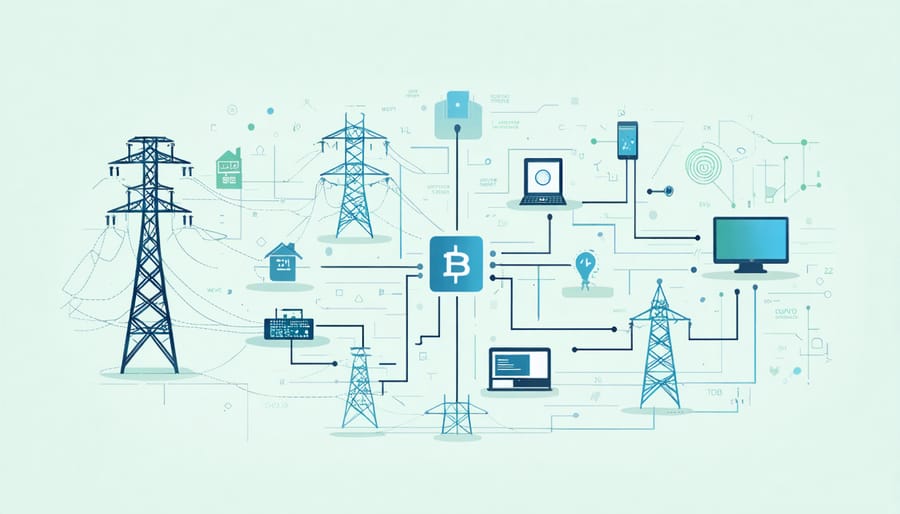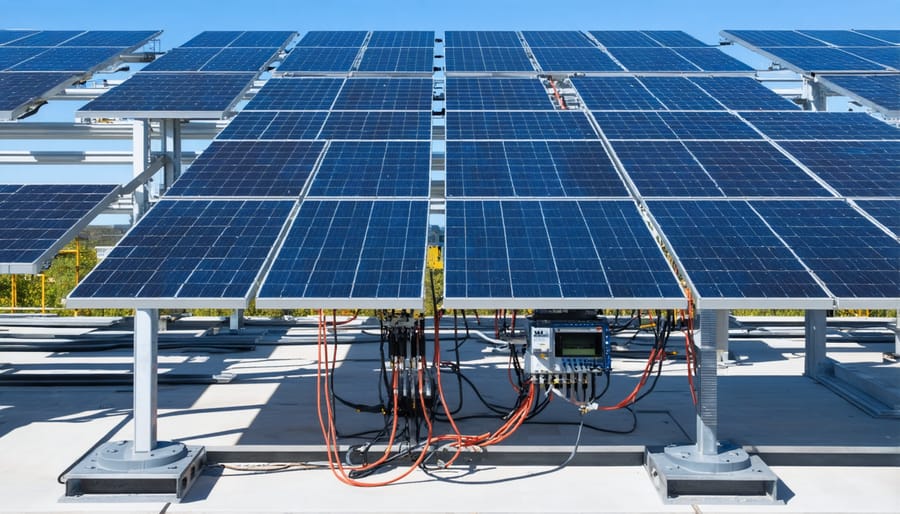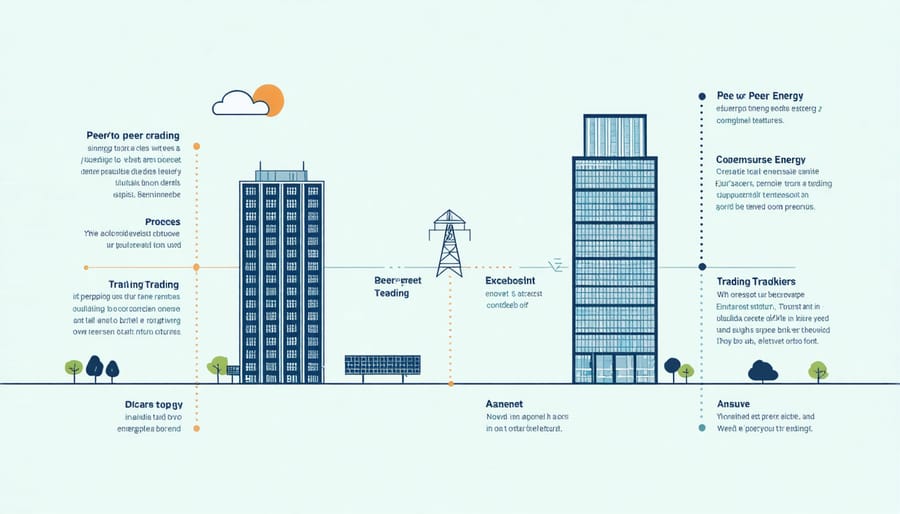Blockchain technology is revolutionizing energy management in construction, offering unprecedented control over resource allocation, consumption tracking, and cost optimization. As the construction industry grapples with increasing energy demands and sustainability requirements, distributed ledger solutions provide a robust framework for transparent, efficient, and secure energy transactions.
By implementing smart contracts and decentralized systems, construction firms can now automate energy procurement, monitor real-time usage across multiple sites, and facilitate peer-to-peer energy trading within microgrids. This technological advancement addresses critical challenges in traditional energy management systems, including data inconsistencies, billing inefficiencies, and lack of transparency in energy consumption patterns.
Leading construction companies have already demonstrated significant cost savings and improved operational efficiency through blockchain implementation. For instance, smart building systems integrated with blockchain networks have achieved 15-25% reduction in energy consumption through automated load balancing and real-time adjustment of resource allocation.
The integration of blockchain in construction energy management represents more than just technological innovation – it’s a fundamental shift toward more sustainable, efficient, and accountable energy practices. For project managers and construction professionals, understanding and implementing blockchain solutions is becoming increasingly crucial for maintaining competitive advantage in an evolving industry landscape.
The Core Architecture of Blockchain in Energy Systems

Distributed Ledger Technology for Energy Trading
Distributed Ledger Technology (DLT) serves as the backbone for secure and transparent energy trading in modern construction projects. By utilizing distributed energy management systems, DLT creates an immutable record of all energy transactions, ensuring accuracy and preventing manipulation of data.
The technology operates through a network of nodes, each maintaining an identical copy of the transaction ledger. When an energy transfer occurs, whether between buildings, microgrids, or utility providers, the transaction is validated by multiple nodes before being permanently recorded. This consensus mechanism eliminates the need for intermediaries while ensuring transaction integrity.
For construction projects implementing on-site renewable energy systems, DLT enables real-time tracking of energy production, consumption, and trading. Smart contracts automatically execute pre-defined agreements, handling payment settlements and energy distribution based on predetermined conditions. This automation reduces administrative overhead and minimizes disputes.
The security features of DLT are particularly valuable in energy trading. Cryptographic protocols protect transaction data, while the decentralized nature of the system prevents single points of failure. Construction firms can track their energy usage patterns, optimize consumption, and participate in energy markets with confidence, knowing that all transactions are secure and verifiable.
Smart Contracts in Energy Management
Smart contracts revolutionize energy management in construction projects by automating and securing energy transactions through self-executing digital agreements. These blockchain-based protocols eliminate intermediaries and streamline processes such as energy trading, consumption monitoring, and payment settlements.
In modern construction projects, smart contracts enable automated energy distribution based on predetermined conditions. For example, when sensors detect peak energy demand in a building, smart contracts can automatically initiate load balancing protocols or trigger renewable energy systems to supplement grid power. This automation reduces operational costs and enhances energy efficiency.
The implementation of smart contracts in energy management offers several key benefits:
– Transparent energy consumption tracking and billing
– Automated compliance with energy regulations
– Reduced administrative overhead
– Enhanced security through cryptographic verification
– Real-time settlement of energy transactions
Leading construction firms are incorporating smart contracts for microgrid management, where building clusters can automatically trade excess energy. For instance, a commercial building with surplus solar power can sell directly to neighboring structures through smart contracts, optimizing energy distribution across the development.
Smart contracts also facilitate performance-based energy agreements, where payment terms automatically adjust based on actual energy consumption patterns and efficiency metrics. This creates accountability and incentivizes sustainable energy practices throughout the building lifecycle, while ensuring fair compensation for energy providers and consumers alike.
Practical Applications in Construction Projects

Microgrid Management and Control
Blockchain technology is revolutionizing microgrid management by enabling decentralized control and automated operations. When integrated with smart grid technology, blockchain creates a secure and transparent framework for managing local energy networks.
The system facilitates peer-to-peer energy trading within microgrids, allowing building owners and operators to optimize energy consumption and distribution in real-time. Smart contracts automatically execute energy transactions based on predetermined conditions, such as pricing thresholds or peak demand periods, ensuring efficient resource allocation.
Blockchain’s distributed ledger technology maintains an immutable record of all energy transactions, consumption patterns, and grid operations. This transparency enables better decision-making for facility managers and helps identify opportunities for energy optimization. The technology also enhances grid reliability by providing automated fault detection and rapid response capabilities.
For construction professionals, implementing blockchain-based microgrid management systems offers several advantages. These include reduced operational costs, improved energy security, and enhanced grid resilience. The system can automatically balance supply and demand, integrate renewable energy sources, and manage energy storage systems with minimal human intervention.
Real-world implementations have demonstrated up to 15% reduction in energy costs and significant improvements in grid stability. This makes blockchain-enabled microgrid management an essential consideration for modern construction projects focused on sustainability and operational efficiency.
Peer-to-Peer Energy Trading Systems
Peer-to-peer energy trading represents a transformative application of blockchain technology in commercial buildings, enabling direct energy transactions between participants within decentralized energy systems. This innovative approach allows building owners and operators to optimize energy consumption and costs while maintaining grid stability.
In commercial implementations, smart contracts automatically execute energy trades based on predetermined conditions, such as pricing thresholds and energy availability. Buildings equipped with solar panels or other renewable energy sources can sell excess power directly to neighboring facilities, creating a local energy marketplace that reduces transmission losses and grid dependency.
Recent case studies demonstrate significant cost savings through P2P trading. The Commerce Building in Sydney achieved a 28% reduction in energy costs within six months of implementing blockchain-based energy trading. The system utilizes advanced metering infrastructure (AMI) and IoT sensors to track real-time energy production and consumption, ensuring transparent and accurate transactions.
Key implementation requirements include:
– Smart meters with blockchain integration capabilities
– Secure communication protocols
– Energy management systems with automated trading functions
– Regulatory compliance mechanisms
– User-friendly interfaces for building managers
For successful deployment, building owners should partner with experienced blockchain solution providers and ensure compatibility with existing building management systems. Regular system audits and performance monitoring help optimize trading strategies and maintain system efficiency.

Energy Data Management and Security
Blockchain technology provides a robust framework for managing and securing energy data across construction projects and operational facilities. The distributed ledger system creates an immutable record of energy transactions, consumption patterns, and grid interactions, ensuring data integrity and transparency throughout the energy management process.
In construction applications, blockchain enables secure monitoring of energy usage across multiple stakeholders, from contractors to facility managers. Each energy transaction is cryptographically sealed and time-stamped, creating an audit trail that helps prevent data manipulation and unauthorized access. This becomes particularly crucial in large-scale projects where multiple parties need access to energy consumption data.
Smart contracts automated through blockchain platforms facilitate secure data sharing while maintaining strict access controls. These contracts can automatically execute predetermined actions based on energy usage thresholds, ensuring compliance with regulatory requirements and project specifications. For instance, when energy consumption exceeds set parameters, the system can trigger automatic notifications or adjustments without compromising data security.
The technology also enhances grid security by providing decentralized data storage. Unlike traditional centralized systems, blockchain’s distributed architecture makes it significantly more resistant to cyber attacks and data breaches. This robust security framework is essential for protecting sensitive energy infrastructure information and maintaining operational continuity in modern construction projects.
Construction firms implementing blockchain-based energy data management systems report improved transparency in energy trading, reduced disputes over usage data, and enhanced ability to meet sustainability reporting requirements while maintaining data security standards.
Implementation Challenges and Solutions
Technical Infrastructure Requirements
Implementing blockchain technology for energy management requires a robust technical infrastructure that combines specialized hardware and software components. At its core, the system needs high-performance servers with sufficient processing power to handle distributed ledger operations and smart contract execution. These servers should be equipped with multi-core processors, minimum 16GB RAM, and solid-state drives for optimal performance.
The network infrastructure must support secure, high-speed connections between nodes, typically requiring enterprise-grade routers and switches with advanced encryption capabilities. For effective integration with existing building energy management strategies, smart meters and IoT sensors must be blockchain-compatible, featuring secure communication protocols and tamper-proof hardware.
On the software side, organizations need to implement blockchain platforms such as Hyperledger Fabric or Ethereum Enterprise, depending on their specific requirements. These platforms must be supported by robust database systems, API integration tools, and security software including hardware security modules (HSMs) for cryptographic key management.
Additional requirements include:
– Backup power systems to maintain network integrity
– Redundant storage solutions for blockchain data
– Edge computing devices for real-time data processing
– Monitoring and analytics software for system performance
– User interface applications for stakeholder access and control
Regulatory Compliance and Standards
The implementation of blockchain technology in energy systems must adhere to a complex framework of regulations and standards across multiple jurisdictions. In the United States, the Federal Energy Regulatory Commission (FERC) has established guidelines for distributed energy resources and peer-to-peer energy trading, which directly impact blockchain-based energy solutions in construction projects.
Smart contracts and energy transactions must comply with state-specific utility regulations and renewable energy certificates (RECs) requirements. Project managers need to ensure their blockchain implementations align with ISO 50001 for energy management systems and IEEE 2418.2-2020 standards for blockchain in energy applications.
Data privacy considerations are particularly crucial, with platforms requiring compliance with GDPR in European projects and various state-level privacy laws in the US. The Energy Web Foundation has developed standardized protocols for blockchain energy applications, which are increasingly becoming industry benchmarks.
For construction professionals, key compliance areas include:
– Grid interconnection standards
– Energy measurement and verification protocols
– Cybersecurity requirements for energy infrastructure
– Environmental reporting and carbon tracking regulations
– Local building codes related to energy systems
Regular audits and certification processes are essential to maintain compliance. Construction firms must work closely with regulatory bodies and maintain detailed documentation of their blockchain energy systems to ensure ongoing adherence to evolving standards and requirements.
Future Outlook and Industry Impact
The future of blockchain in energy management shows tremendous promise, with industry experts projecting significant growth and transformation over the next decade. Market analysis indicates that blockchain-based energy solutions could reach a market value of $25 billion by 2025, revolutionizing how construction projects manage and trade energy resources.
Several key trends are emerging that will shape the industry’s evolution. Peer-to-peer energy trading platforms are expected to become mainstream, enabling construction sites and buildings to directly exchange surplus energy with neighboring facilities. This decentralized approach could reduce energy costs by 15-30% while promoting sustainable resource utilization.
Smart contracts will increasingly automate energy management processes, with AI integration enabling predictive maintenance and optimal resource allocation. Industry forecasts suggest that by 2027, over 40% of new commercial buildings will incorporate blockchain-based energy management systems as standard practice.
Regulatory frameworks are also evolving to accommodate blockchain technology. Several countries are developing specific guidelines for blockchain-based energy trading, which will provide clearer pathways for implementation in construction projects. This regulatory clarity is expected to accelerate adoption rates across the industry.
Emerging technologies like 5G and IoT will enhance blockchain’s capabilities in energy management. The combination of these technologies will enable real-time monitoring and automated response systems that can adjust energy consumption patterns based on immediate needs and market conditions.
However, challenges remain. The industry must address concerns about scalability, energy consumption of blockchain networks, and integration with legacy systems. Solutions are being developed, including more energy-efficient consensus mechanisms and hybrid systems that combine blockchain with traditional databases.
The construction sector stands to benefit significantly from these developments. Projects implementing blockchain-based energy management systems are projected to achieve 25-40% improvements in energy efficiency, while reducing administrative costs by up to 30%. These improvements will contribute substantially to meeting increasingly stringent sustainability requirements and environmental regulations.
As the construction industry continues to evolve, blockchain technology presents a transformative opportunity for energy management. The key to successful implementation lies in strategic planning, stakeholder engagement, and phased adoption. Construction professionals should start by identifying specific energy-related pain points in their projects, then evaluate blockchain solutions that address these challenges directly. Prioritize platforms offering smart contract capabilities, real-time energy monitoring, and secure data sharing. Begin with pilot projects to demonstrate value and build expertise before scaling across operations. Remember that successful blockchain adoption requires collaboration between technology providers, energy utilities, and construction teams. Stay informed about regulatory developments and industry standards while maintaining focus on practical applications that deliver measurable benefits to your construction projects. The future of construction energy management is increasingly decentralized and transparent – positioning your organization now will ensure competitive advantage in this evolving landscape.

